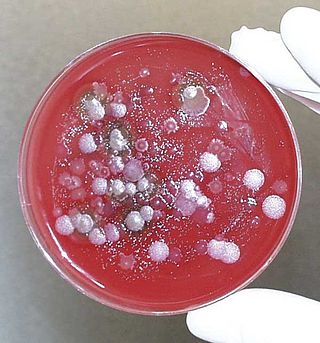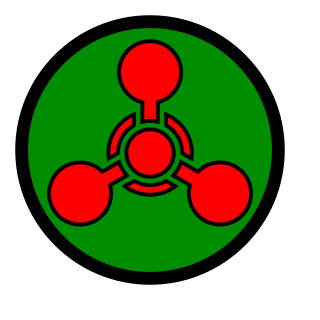Related Research Articles

Biological warfare, also known as germ warfare, is the use of biological toxins or infectious agents such as bacteria, viruses, insects, and fungi with the intent to kill, harm or incapacitate humans, animals or plants as an act of war. Biological weapons are living organisms or replicating entities. Entomological (insect) warfare is a subtype of biological warfare.

Chemical warfare (CW) involves using the toxic properties of chemical substances as weapons. This type of warfare is distinct from nuclear warfare, biological warfare and radiological warfare, which together make up CBRN, the military acronym for chemical, biological, radiological, and nuclear, all of which are considered "weapons of mass destruction" (WMDs), a term that contrasts with conventional weapons.
The Protocol for the Prohibition of the Use in War of Asphyxiating, Poisonous or other Gases, and of Bacteriological Methods of Warfare, usually called the Geneva Protocol, is a treaty prohibiting the use of chemical and biological weapons in international armed conflicts. It was signed at Geneva on 17 June 1925 and entered into force on 8 February 1928. It was registered in League of Nations Treaty Series on 7 September 1929. The Geneva Protocol is a protocol to the Convention for the Supervision of the International Trade in Arms and Ammunition and in Implements of War signed on the same date, and followed the Hague Conventions of 1899 and 1907.

The Chemical Weapons Convention (CWC), officially the Convention on the Prohibition of the Development, Production, Stockpiling and Use of Chemical Weapons and on their Destruction, is an arms control treaty administered by the Organisation for the Prohibition of Chemical Weapons (OPCW), an intergovernmental organization based in The Hague, The Netherlands. The treaty entered into force on 29 April 1997, and prohibits the large-scale use, development, production, stockpiling and transfer of chemical weapons and their precursors, except for very limited purposes. The main obligation of member states under the convention is to effect this prohibition, as well as the destruction of all current chemical weapons. All destruction activities must take place under OPCW verification.

The Biological Weapons Convention (BWC), or Biological and Toxin Weapons Convention (BTWC), is a disarmament treaty that effectively bans biological and toxin weapons by prohibiting their development, production, acquisition, transfer, stockpiling and use. The treaty's full name is the Convention on the Prohibition of the Development, Production and Stockpiling of Bacteriological (Biological) and Toxin Weapons and on their Destruction.

A biological agent is a bacterium, virus, protozoan, parasite, fungus, or toxin that can be used purposefully as a weapon in bioterrorism or biological warfare (BW). In addition to these living or replicating pathogens, toxins and biotoxins are also included among the bio-agents. More than 1,200 different kinds of potentially weaponizable bio-agents have been described and studied to date.
The National Biodefense Analysis and Countermeasures Center (NBACC) is a government biodefense research laboratory created by the U.S. Department of Homeland Security (DHS) and located at the sprawling biodefense campus at Fort Detrick in Frederick, MD, USA. The NBACC is the principal U.S. biodefense research institution engaged in laboratory-based threat assessment and bioforensics. NBACC is an important part of the National Interagency Biodefense Campus (NIBC) also located at Fort Detrick for the US Army, National Institutes of Health and the US Department of Agriculture.
The United States biological weapons program officially began in spring 1943 on orders from U.S. President Franklin Roosevelt. Research continued following World War II as the U.S. built up a large stockpile of biological agents and weapons. Over the course of its 27-year history, the program weaponized and stockpiled the following seven bio-agents :
Project Clear Vision was a covert examination of Soviet-made biological bomblets conducted by the Battelle Memorial Institute under contract with the CIA. The legality of this project under the Biological Weapons Convention (BWC) of 1972 is disputed.

The Soviet Union covertly operated the world's largest, longest, and most sophisticated biological weapons program, thereby violating its obligations as a party to the 1972 Biological Weapons Convention. The program began in the 1920s and lasted until at least September 1992 but has possibly been continued by Russia after that.
This article deals with activities of the U.S. Central Intelligence Agency, specifically dealing with arms control, weapons of mass destruction (WMD) and weapons proliferation. It attempts to look at the process of tasking and analyzing, rather than the problem itself, other than whether the CIA's efforts match its legal mandate or assists in treaty compliance. In some cases, the details of a country's programs are introduced because they present a problem in analysis. For example, if Country X's policymakers truly believe in certain history that may not actually be factual, an analyst trying to understand Country X's policymakers needs to be able to understand their approach to an issue.
The "Statement on Chemical and Biological Defense Policies and Programs" was a speech delivered on November 25, 1969, by U.S. President Richard Nixon. In the speech, Nixon announced the end of the U.S. offensive biological weapons program and reaffirmed a no-first-use policy for chemical weapons. The statement excluded toxins, herbicides and riot-control agents as they were not chemical and biological weapons, though herbicides and toxins were both later banned. The decision to ban biological weapons was influenced by a number of domestic and international issues.

The U.S. Army Edgewood Chemical Biological Center (ECBC) is the United States's principal research and development resource for non-medical chemical and biological (CB) defense. As a critical national asset in the CB defense community, ECBC supports all phases of the acquisition life-cycle ― from basic and applied research through technology development, engineering design, equipment evaluation, product support, sustainment, field operations and demilitarization ― to address its customers’ unique requirements.
Entomological warfare (EW) is a type of biological warfare that uses insects to interrupt supply lines by damaging crops, or to directly harm enemy combatants and civilian populations. There have been several programs which have attempted to institute this methodology; however, there has been limited application of entomological warfare against military or civilian targets, Japan being the only state known to have verifiably implemented the method against another state, namely the Chinese during World War II. However, EW was used more widely in antiquity, in order to repel sieges or cause economic harm to states. Research into EW was conducted during both World War II and the Cold War by numerous states such as the Soviet Union, United States, Germany and Canada. There have also been suggestions that it could be implemented by non-state actors in a form of bioterrorism. Under the Biological and Toxic Weapons Convention of 1972, use of insects to administer agents or toxins for hostile purposes is deemed to be against international law.

The Biological Weapons Anti-Terrorism Act of 1989 (BWATA), Pub. L. 101–298, enacted May 22, 1990) was a piece of U.S. legislation that was passed into law in 1990. It provided for the implementation of the Biological Weapons Convention as well as criminal penalties for violation of its provisions. The law was amended in 1996 and has been used to prosecute several individuals.
VEREX was an ad hoc committee assembled in 1991 by the Third Review Conference of the Biological Weapons Convention (BWC) to research verification measures to enforce the BWC from a scientific and technical standpoint.

A chemical weapon (CW) is a specialized munition that uses chemicals formulated to inflict death or harm on humans. According to the Organisation for the Prohibition of Chemical Weapons (OPCW), this can be any chemical compound intended as a weapon "or its precursor that can cause death, injury, temporary incapacitation or sensory irritation through its chemical action. Munitions or other delivery devices designed to deliver chemical weapons, whether filled or unfilled, are also considered weapons themselves."
The Biological and Chemical Defence Review Committee, or BCDRC is a civilian body having oversight of the Canadian military's activities in the area of defence against biological and chemical warfare.
The United States biological defense program—in recent years also called the National Biodefense Strategy—refers to the collective effort by all levels of government, along with private enterprise and other stakeholders, in the United States to carry out biodefense activities.
References
- ↑ "The General Purpose Criterion and the Schedules of the Chemical Weapons Convention" (PDF). Archived from the original (PDF) on 2011-12-05. Retrieved 2010-10-23.
- ↑ Pearson, G. S. (October 15, 2006). "The Importance of Implementation of the General Purpose Criterion of the Chemical Weapons Convention". Kemija u industriji: Časopis kemičara i kemijskih inženjera Hrvatske. 55 (10): 413–422 – via hrcak.srce.hr.
- ↑ Marrs, Timothy T.; Maynard, Robert L.; Sidell, Frederick (May 7, 2007). Chemical Warfare Agents: Toxicology and Treatment. John Wiley & Sons. ISBN 9780470013595 – via Google Books.
- ↑ "No time for complacency: tackling challenges to the Chemical Weapons Convention | Arms Control Association". www.armscontrol.org.
- ↑ Powered by Google Docs
- ↑ "Educational Module on CBW: General-purpose criterion".
- ↑ "Text of the Treaty: Biological Weapons Convention". United Nations Office for Disarmament Affairs. Retrieved 2020-11-04.
- ↑ Final Document of the Eighth Review Conference. Eighth Review Conference of the States Parties to the BWC. 2017. pp. Part II, Article I, paragraph 2.